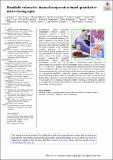Files in this item
Handheld volumetric manual compression-based quantitative microelastography
Item metadata
| dc.contributor.author | Fang, Qi | |
| dc.contributor.author | Frewer, Luke | |
| dc.contributor.author | Zilkens, Renate | |
| dc.contributor.author | Krajancich, Brooke | |
| dc.contributor.author | Curatolo, Andrea | |
| dc.contributor.author | Chin, Lixin | |
| dc.contributor.author | Foo, Ken Y | |
| dc.contributor.author | Lakhiani, Devina D | |
| dc.contributor.author | Sanderson, Rowan W | |
| dc.contributor.author | Wijesinghe, Philip | |
| dc.contributor.author | Anstie, James D | |
| dc.contributor.author | Dessauvagie, Benjamin F | |
| dc.contributor.author | Latham, Bruce | |
| dc.contributor.author | Saunders, Christobel M | |
| dc.contributor.author | Kennedy, Brendan F | |
| dc.date.accessioned | 2021-02-27T00:35:40Z | |
| dc.date.available | 2021-02-27T00:35:40Z | |
| dc.date.issued | 2020-02-27 | |
| dc.identifier | 266563249 | |
| dc.identifier | 707981ed-baab-4501-bd16-2ee8590ec780 | |
| dc.identifier | 32057188 | |
| dc.identifier | 85080104637 | |
| dc.identifier | 000516710400001 | |
| dc.identifier.citation | Fang , Q , Frewer , L , Zilkens , R , Krajancich , B , Curatolo , A , Chin , L , Foo , K Y , Lakhiani , D D , Sanderson , R W , Wijesinghe , P , Anstie , J D , Dessauvagie , B F , Latham , B , Saunders , C M & Kennedy , B F 2020 , ' Handheld volumetric manual compression-based quantitative microelastography ' , Journal of Biophotonics , vol. Early View , e201960196 . https://doi.org/10.1002/jbio.201960196 | en |
| dc.identifier.issn | 1864-063X | |
| dc.identifier.other | ORCID: /0000-0002-8378-7261/work/70234064 | |
| dc.identifier.uri | https://hdl.handle.net/10023/21519 | |
| dc.description | This research was supported by grants and fellowships from the Australian Research Council, the National Health and Medical Research Council (Australia), the National Breast Cancer Foundation (Australia), the Department of Health, Western Australia, the Cancer Council, Western Australia and through a research contract with OncoRes Medical, Australia. | en |
| dc.description.abstract | Compression optical coherence elastography (OCE) typically requires a mechanical actuator to impart a controlled uniform strain to the sample. However, for handheld scanning, this adds complexity to the design of the probe and the actuator stroke limits the amount of strain that can be applied. In this work, we present a new volumetric imaging approach that utilizes bidirectional manual compression via the natural motion of the user's hand to induce strain to the sample, realizing compact, actuator‐free, handheld compression OCE. In this way, we are able to demonstrate rapid acquisition of three‐dimensional quantitative microelastography (QME) datasets of a tissue volume (6 × 6 × 1 mm3) in 3.4 seconds. We characterize the elasticity sensitivity of this freehand manual compression approach using a homogeneous silicone phantom and demonstrate comparable performance to a benchtop mounted, actuator‐based approach. In addition, we demonstrate handheld volumetric manual compression‐based QME on a tissue‐mimicking phantom with an embedded stiff inclusion and on freshly excised human breast specimens from both mastectomy and wide local excision (WLE) surgeries. Tissue results are coregistered with postoperative histology, verifying the capability of our approach to measure the elasticity of tissue and to distinguish stiff tumor from surrounding soft benign tissue. | |
| dc.format.extent | 1719713 | |
| dc.language.iso | eng | |
| dc.relation.ispartof | Journal of Biophotonics | en |
| dc.subject | Freehand volumetric imaging | en |
| dc.subject | Handheld probe | en |
| dc.subject | Optical coherence elastography | en |
| dc.subject | Optical coherence tomography | en |
| dc.subject | Quantitative micro-elastrogrophy | en |
| dc.subject | QC Physics | en |
| dc.subject | QH301 Biology | en |
| dc.subject | RD Surgery | en |
| dc.subject | T Technology | en |
| dc.subject | T-NDAS | en |
| dc.subject.lcc | QC | en |
| dc.subject.lcc | QH301 | en |
| dc.subject.lcc | RD | en |
| dc.subject.lcc | T | en |
| dc.title | Handheld volumetric manual compression-based quantitative microelastography | en |
| dc.type | Journal article | en |
| dc.contributor.institution | University of St Andrews. School of Physics and Astronomy | en |
| dc.identifier.doi | https://doi.org/10.1002/jbio.201960196 | |
| dc.description.status | Peer reviewed | en |
| dc.date.embargoedUntil | 2021-02-27 |
This item appears in the following Collection(s)
Items in the St Andrews Research Repository are protected by copyright, with all rights reserved, unless otherwise indicated.

